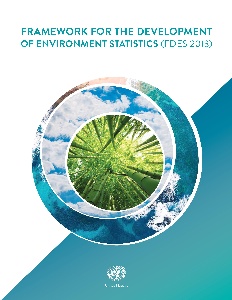Versions Compared
Key
- This line was added.
- This line was removed.
- Formatting was changed.
 The FDES provides guidance on a core set of environmental indicators that has proven beneficial to inform policy. It is designed to assist all countries in articulating environment statistics programmes by:
The FDES provides guidance on a core set of environmental indicators that has proven beneficial to inform policy. It is designed to assist all countries in articulating environment statistics programmes by:
- delineating the scope of environment statistics and identifying its constituents;
- contributing to the assessment of data requirements, sources, availability and gaps;
- guiding the development of multipurpose data collection processes and databases; and
- assisting in coordination and organization across institutions.
The FDES (Framework for the Development of Environment Statistics) describes the scope and components of environment statistics as measuring:
- The state of the environment
- Our dependence on the environment
- Our impact on it
- Its impact on us (even negative ones)
- How we protect and manage it
Chapter 1 Overview of Environment Statistics | Presentations | Exercises |
|---|---|---|
Overview of Environment Statistics – Characteristics and Challenges | ||
Chapter 2 Conceptual Foundation and Structure | Presentations | Exercises |
Conceptual Foundation and Structure | ||
Chapter 3: Components of the FDES and the Basic Set of Environment Statistics | Presentations | Exercises |
3.1 Environmental Conditions and Quality | ||
3.2 Environmental Resources and Their Use | ||
3.3 Residuals | ||
3.4 Extreme Events and Disasters | ||
3.5 Human Settlements and Environmental Health | ||
3.6 Environmental Protection, Management and Engagement | ||
Chapter 4: From the Basic Set to the Core Set of Environment Statistics | Presentations | Exercises |
From the Basic Set to the Core Set of Environment Statistics | n/a |
Pages
| Page Tree | ||
|---|---|---|
|
Go to: FDES Manual (English)
A note to the user:
The materials are in progress and are subject to change. They are necessarily simplifications of the materials in the guidance documents, which should be the main reference for producing statistics and accounts.
Disclaimer:
These materials are free for you to use, adapt and translate. If you do adapt them, please acknowledge ESCAP. They were produced in collaboration with many partners, who are acknowledged in the documents. They have benefitted from testing and feedback from many workshop participants.
Please contact us (stat.unescap@un.org) if you have viewed the presentations. We would be interested in hearing your views on how we could improve the materials.